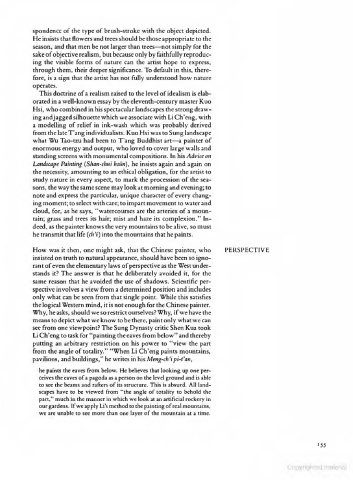Page 175 - The Arts of China, By Michael Sullivan Good Book
P. 175
spondcncc of the type of brush-stroke with the object depicted.
He insists that flowers and trees should be those appropriate to the
season, and that men be not larger than trees—not simply for the
sake of objective realism, but because only by faithfully reproduc-
ing the visible forms of nature can the artist hope to express,
through them, their deeper significance. To default in this, there-
fore, is a sign that the artist has not fully understood how nature
operates.
This doctrine of a realism raised to the level of idealism is elab-
orated in a well-known essay by the eleventh-century master Kuo
Hsi, who combined in his spectacular landscapes the strong draw-
ing andjagged silhouette which we associate with Li Ch'eng, with
a modelling of relief in ink-wash which was probably derived
from the late T'ang individualists. Kuo Hsi was to Sung landscape
what Wu Tao-tzu had been to T'ang Buddhist art—a painter of
enormous energy and output, who loved to cover large walls and
standing screens with monumental compositions. In his Advice on
Landscape Painting (Shan-shui hsiin), he insists again and again on
the necessity, amounting to an ethical obligation, for the artist to
study nature in every aspect, to mark the procession of the sea-
sons, the way the same scene may look at morning and evening; to
note and express the particular, unique character of every chang-
ing moment; to select with care; to impart movement to water and
cloud, for, as he says, "watercourses are the arteries of a moun-
tain; grass and trees its hair; mist and haze its complexion." In-
deed, as the painter knows the very mountains to be alive, so must
he transmit that life (ch'i) into the mountains that he paints.
How was it then, one might ask, that the Chinese painter, who PERSPECTIVE
insisted on truth to natural appearance, should have been so igno-
rant of even the elementary laws of perspective as the West under-
stands it? The answer is that he deliberately avoided it, for the
same reason that he avoided the use of shadows. Scientific per-
spective involves a view from a determined position and includes
only what can be seen from that single point. While this satisfies
the logical Western mind, it is not enough for the Chinese painter.
Why, he asks, should we so restrict ourselves? Why, ifwe have the
means to depict what we know to be there, paint only what we can
sec from one viewpoint? The Sung Dynasty critic Shen Kua took
Li Ch'eng to task for "painting the eaves from below" and thereby
putting an arbitrary restriction on his power to "view the part
from the angle of totality." "When Li Ch'eng paints mountains,
pavilions, and buildings," he writes in his Meng-ch'i pi-t'an,
he paints the eaves from below. He believes that looking up one per-
ceives the caves of a pagoda as a person on the level ground and is able
to see the beams and rafters of its structure. This is absurd. All land-
scapes have to be viewed from "the angle of totality to behold the
part," much in the manner in which we look at an artificial rockery in
our gardens. Ifwe apply Li's method to the painting of real mountains,
we are unable to see more than one layer of the mountain at a time.
155
Copyrighted material

